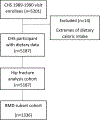Association of Dietary Niacin Intake With Incident Hip Fracture, BMD, and Body Composition: The Cardiovascular Health Study
- PMID: 30659655
- PMCID: PMC6663556
- DOI: 10.1002/jbmr.3639
Association of Dietary Niacin Intake With Incident Hip Fracture, BMD, and Body Composition: The Cardiovascular Health Study
Abstract
Interest in niacin has increased in the setting of reports suggesting that niacin plays a role in diseases of aging. No study to date has examined the association of dietary niacin intake with multiple skeletal health parameters including bone mineral density (BMD), hip fractures, and body composition, and none have included both African American and white men and women. Participants included 5187 men and women ≥65 years from the Cardiovascular Health Study (CHS). Mean daily dietary niacin intake was 32.6 mg, with quartiles 1 through 4 defined as 3.6 to 21.8 mg/day, 21.9 to 30.2 mg/day, 30.3 to 40.9 mg/day, and 41.0 to 102.4 mg/day, respectively. Risk of incident hip fracture per 10 mg increment of daily dietary niacin intake was estimated using proportional hazards models. During a median follow-up of 13 years, 725 participants had an incident hip fracture. In models adjusted for demographic and clinical characteristics and diet, dietary niacin intake was significantly associated with an increased risk of hip fractures (hazard ratio [HR] 1.12; 95% CI, 1.01 to 1.24) with spline models suggesting a U-shaped association. In post hoc analyses, both the lowest (HR 1.31; 95% CI, 1.04 to 1.66) and highest (HR 1.53; 95% CI, 1.20 to 1.95) quartiles of niacin intake were associated with an increased risk of incident hip fracture versus quartiles 2 and 3. There was a trend for a significant inverse association of dietary niacin intake with hip BMD (p = 0.06), but no significant association with total body BMD or any body composition measures. In this cohort of elderly, community-dwelling African American and white men and women, both high and low dietary niacin intakes were associated with a significantly increased risk of subsequent hip fracture, suggesting a possible U-shaped association. By comparison, dietary niacin may have an inverse linear association with hip BMD. © 2018 American Society for Bone and Mineral Research.
Keywords: AGING; EPIDEMIOLOGY; NUTRITION.
© 2018 American Society for Bone and Mineral Research.
Figures




Similar articles
-
The Association of Aromatic Amino Acids with Incident Hip Fracture, aBMD, and Body Composition from the Cardiovascular Health Study.Calcif Tissue Int. 2019 Aug;105(2):161-172. doi: 10.1007/s00223-019-00562-9. Epub 2019 May 21. Calcif Tissue Int. 2019. PMID: 31115639 Free PMC article.
-
Associations of 25-Hydroxyvitamin D and 1,25-Dihydroxyvitamin D With Bone Mineral Density, Bone Mineral Density Change, and Incident Nonvertebral Fracture.J Bone Miner Res. 2015 Aug;30(8):1403-13. doi: 10.1002/jbmr.2487. Epub 2015 May 22. J Bone Miner Res. 2015. PMID: 25707402 Free PMC article. Clinical Trial.
-
Lipoprotein(a) plasma levels, bone mineral density and risk of hip fracture: a post hoc analysis of the Women's Health Initiative, USA.BMJ Open. 2019 Apr 24;9(4):e027257. doi: 10.1136/bmjopen-2018-027257. BMJ Open. 2019. PMID: 31023762 Free PMC article. Clinical Trial.
-
Soy protein consumption and bone mass in early postmenopausal Chinese women.Osteoporos Int. 2003 Oct;14(10):835-42. doi: 10.1007/s00198-003-1453-9. Epub 2003 Aug 14. Osteoporos Int. 2003. PMID: 12920508 Review.
-
How well you absorb calcium is important for limiting hip fracture risk.Nutr Rev. 2001 Oct;59(10):338-41. doi: 10.1111/j.1753-4887.2001.tb06959.x. Nutr Rev. 2001. PMID: 11669240 Review.
Cited by
-
Association Between Dietary Niacin Intake and Rheumatoid Arthritis in American Women: A Study Based on National Health and Nutrition Examination Survey Database.Int J Womens Health. 2024 Dec 19;16:2209-2219. doi: 10.2147/IJWH.S482294. eCollection 2024. Int J Womens Health. 2024. PMID: 39717391 Free PMC article.
-
Recent advances in the identification of related factors and preventive strategies of hip fracture.Front Public Health. 2023 Mar 13;11:1006527. doi: 10.3389/fpubh.2023.1006527. eCollection 2023. Front Public Health. 2023. PMID: 36992874 Free PMC article. Review.
-
The Association of Aromatic Amino Acids with Incident Hip Fracture, aBMD, and Body Composition from the Cardiovascular Health Study.Calcif Tissue Int. 2019 Aug;105(2):161-172. doi: 10.1007/s00223-019-00562-9. Epub 2019 May 21. Calcif Tissue Int. 2019. PMID: 31115639 Free PMC article.
-
Comprehensive health assessment of retired martial arts athletes: bone density, dietary intake, physical activity, and wellbeing.Front Aging. 2025 Feb 3;6:1513936. doi: 10.3389/fragi.2025.1513936. eCollection 2025. Front Aging. 2025. PMID: 39963687 Free PMC article.
-
Association of dietary niacin intake with all-cause mortality in chronic kidney disease: A retrospective cohort study of NHANES.PLoS One. 2025 Feb 7;20(2):e0313398. doi: 10.1371/journal.pone.0313398. eCollection 2025. PLoS One. 2025. PMID: 39919081 Free PMC article.
References
-
- Bonjour JP, Schurch MA, Rizzoli R Nutritional aspects of hip fractures. Bone. 1996; 18( 3 Suppl): 139s–44s. - PubMed
-
- Jordan KM, Cooper C Epidemiology of osteoporosis. Best Pract Res Clin Rheumatol. 2002; 16( 5): 795–806. - PubMed
-
- Sambrook P, Cooper C Osteoporosis. Lancet. 2006; 367( 9527): 2010–8. - PubMed
-
- Erdman J Present Knowledge in Nutrition. 10th ed Oxford: Wiley-Blackwell; 2012.
Publication types
MeSH terms
Substances
Grants and funding
LinkOut - more resources
Full Text Sources
Medical

